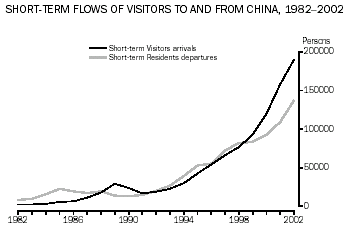Feature Article - China's Tourists
CHINA'S TOURISTS
The current population of China is 1.3 billion and for this considerable population there is a rapidly growing travel industry. Most Chinese travel within China, but more and more are venturing overseas, primarily with the aid of packaged-tour groups. Because of increased earning power, a more international outlook and fewer official restrictions, overseas travel for work, study and leisure are booming for the Chinese (Murphy, 2002). The number of Chinese embarking on international travel is dramatically increasing. According to the China National Tourism Administration, it was estimated that 10.5 million Chinese travelled outside of China in 2000, 13% more than in 1999. The World Tourism Organisation estimates the number of Chinese travellers will increase to 100 million by 2020 (Murphy, 2002). It is anticipated that the Chinese will replace the Americans, Japanese and Germans as the world's top travellers (The Economist, 2002).
Australia is among the tourist destinations currently preferred by the Chinese. Countries, such as Canada, Finland and Switzerland are looking at ways to make it easier for the Chinese to get tourists visas. A major worry of the Chinese Government is that tourists may overstay their visas or claim refugee status on arrival (The Economist, 2002). These countries are negotiating with the Chinese Government to join Australia, New Zealand, Germany, Hong Kong, Turkey and most of South East Asia in getting Approved Destination Status (ADS). Under ADS Beijing sets out-bound quotas for packaged tours organised by state-owned travel agencies, whose function is to ensure nobody in their group absconds. In September 2002 Beijing licensed 461 new agencies, on top of the mere 67 that were previously offering such holidays, further adding to China's rapidly expanding travel industry (The Economist, 2002). The Australian Tourism Commission in Shanghai reported the average Chinese tourist stayed 10 nights in Australia and spent A$4,441. Due to the potential of the Chinese tourist market, some countries are going out of their way to lure the Chinese tourists (Murphy, 2002).
FLOWS TO AND FROM CHINA
With the exception of 1989 to 1991, the number of Australian residents visiting China on a short-term basis, has been greater than the number of Chinese visitors to Australia. In recent times this trend has reversed and now looks set to continue as the Chinese tourist market continues to expand. For the year 2002 there were 190,000 short-term visitor arrivals from China, an increase of 20% on 2001 (158,000), compared to 136,900 short-term resident departures from Australia, an increase of 25% on 2001 (109,300).

 Print Page
Print Page
 Print All
Print All